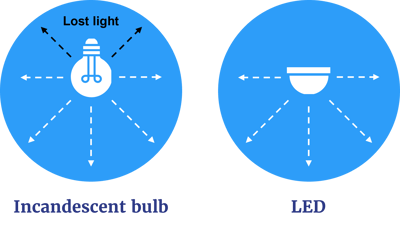From their extensive life span and low running costs through to their positive impact on profitability, the efficiency-related benefits of LED luminaires are something that we’ve covered in detail across our previous posts. Just what is it that makes LEDs so much more efficient than alternative lighting technologies, though? How exactly do they deliver better results while also requiring less power?
In this blog, we’ll explain why LED lights are more efficient than others – and how some smart design choices are enabling smarter outcomes for people and planet alike.
1. More of the electricity that LEDs use is converted into light
Different luminaires create light in different ways. Metal-halide lamps, for instance, contain a combination of mercury and metal halide gas. When electricity is passed through that mixture, the chemical reaction produces a bright white light. The same process is used within sodium vapour floodlights, with both varieties falling into the category of high-intensity discharge (HID) lamps as a result.
LEDs (or, Light Emitting Diodes) are different. An LED is a tiny semiconductor, which, when fed with an electrical current, emits light in the form of photons. In an LED floodlight, a number of individual semiconductors are aligned in what is known as an “array”. By adding more LEDs to an array, and changing its layout, a manufacturer can make a floodlight more or less powerful as needed.
These technical differences are one of the main reasons that LEDs are so much more efficient than their alternatives. When a current is passed through gas, as is the case with a HID lamp, a large amount of the energy used is lost as heat. With LEDs, which generate only a small fraction of the heat that HID lamps do, much more of the power provided is converted directly into visible light.
While this makes LEDs significantly more efficient than HIDs, it also sets them apart from other forms of lighting, too. Incandescent bulbs, which produce light by heating a wire filament, are similarly wasteful in comparison.
2. LED floodlights direct more light to where it’s actually needed
The differences between LED luminaires and the alternatives don’t end with the production of light; one of the other key reasons that LEDs are more efficient is because they’re also more effective when it comes to distributing that light, too.
Any kind of fixed light – be that a floodlight, wall light, or any other variety – is designed to illuminate a specific area. Light that falls outside of that boundary is wasted, as is the power that was used to create it in the first place. Naturally, that makes it important to ensure that light is being directed as effectively as possible. This is something that LEDs excel at, because they emit light in a specific way. Whereas HID and incandescent bulbs are “omnidirectional”, producing light in 360 degrees, LEDs are “directional” – focusing the majority of their light towards a defined point. The result is that LEDs make it easier to distribute light effectively, something that can be further refined by optics like those found in Midstream’s own luminaires.
This is something that LEDs excel at, because they emit light in a specific way. Whereas HID and incandescent bulbs are “omnidirectional”, producing light in 360 degrees, LEDs are “directional” – focusing the majority of their light towards a defined point. The result is that LEDs make it easier to distribute light effectively, something that can be further refined by optics like those found in Midstream’s own luminaires.
While the omnidirectional light produced by HIDs can be shaped using tools like reflectors and diffusers, that in itself can cause light to be wasted. With that then resulting in additional energy consumption, directional light is the clear best choice for any organisation that cares about the efficiency of its floodlighting.
3. Contributing factors play a role, too
The two foundational issues outlined above – energy consumption and directional lighting – are the main reasons that LEDs are so much more efficient than the alternatives. At the same time, LEDs also boast some other capabilities that have a smaller, but still important, impact on efficiency. These include:
• Instant switch-on
As explained in one of our earlier posts, one of the main advantages of LED lights is that they turn on and off instantaneously. While it might not sound particularly revolutionary on its own, that fact becomes all the more important when we consider that metal-halides can take as long as 30 minutes to reach full power when switched on. That’s a considerable amount of energy wasted.
• Control units for dimming
Switch-on speed isn’t the only differentiator between LEDs and the alternatives. LED luminaires can also be dimmed using a control unit, which allows energy to be saved when floodlights don’t need to run at full power. That’s not the case with HIDs, which are only capable of running at max capacity or not at all.
• Extreme longevity
While it doesn’t technically relate to the energy consumption of an individual luminaire, it is difficult to discuss the topic of energy efficiency without acknowledging the long lifespan of LEDs. LED floodlights can remain active as much as 5x longer than metal-halides, which has an onward impact on the energy and raw materials consumed in the manufacturing process.
• Continued innovation
Finally, it bears mentioning that LED technology is continuing to become more efficient as time goes by. While HIDs and other alternatives are already as good as they will ever be in terms of power consumption, LEDs like our own are being continually improved. The gains might now be comparatively small, but LEDs do benefit from ongoing innovation.
To find out how LED floodlights can help you meet your own energy efficiency goals, please get in touch.